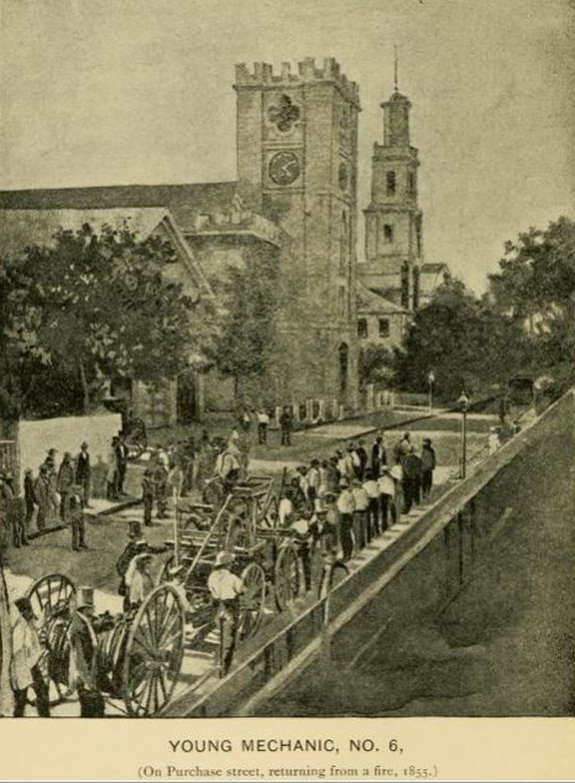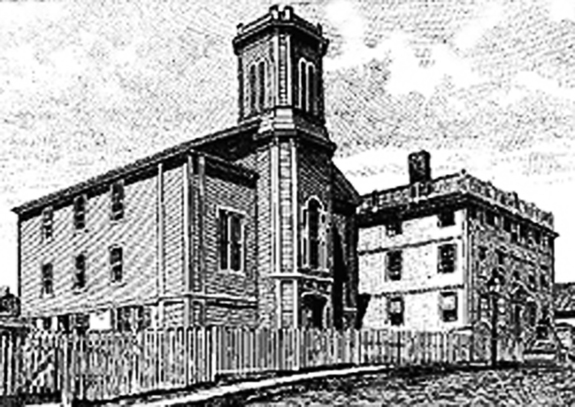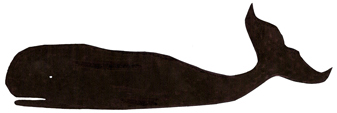Local New Bedford, Ma. History
1850 - 1858 In Chronological Order
|
 |
Young Mechanic no. 6 was a fire engine used in
New Bedford, Ma. in the 1800's
Here it is returning from a fire on Purchase Street 1855 |
| |
By the 1850's due to whaling, New Bedford was considered the richest city in the country and some claim in the world. The wealth was not dispersed evenly. Many of the wealthy were Quakers and not prone to ostentation.
John Avery Parker was the wealthiest man in the city in 1850. |
| |
1850
The "Standard" or "The Daily Evening Standard" is established at 7 North Water Street. Later in the beginning of the 21st century that same lot became the location of the new building for the offices of the Standard-Times.
It was a second newspaper for the city. Founded by Edmund Anthony the first edition was published on February 15 of that year. Anthony and his descendants continued to publish the paper through the rest of the century. |
| |
1850
Congress passed the Fugitive Slave Act.
Anyone suspected of being a runaway slave could be arrested. Any federal marshal or official who didn't arrest a suspected runaway slave would be in big trouble.
The fine for the official or marshall for non-compliance was $1.000.00, an enormous sum in those days.
New Bedford was a hotbed of abolitionist sympathy, and so several events came to pass where the slave catcher went home empty handed and furious. The locals were tricky and stories of their tactics to keep runaways free were almost entertaining when told afterwards.
The bell in Liberty hall sounded when ever a slave catcher came into town warning whoever was worried about being caught that the slavers were about. |
| |
1850
About 85% of the black population many who were escaped slaves were working in what was considered unskilled, semi-skilled and service occupations. Never the less New Bedford enjoyed the highest percentage in all of new England of skilled black people in the workforce.
As years passed, the percentage of blacks in more skilled occupations rose. (See 1856)
The Martha and Henry Onley Homestead are
located at 147 Smith Street, on the corner with Cedar Street
The Onleys built the house in 1850.
Their home became a focal point of African-American history and literature.
The Martha Briggs Literary Society was organized here.
The Onleys helped organize the Salem Baptist Church.
After Henry Onley had died in the late 1880s, his wife lived on the rents from property she owned.
Charles Dudley Onley, her grandson used the house as a funeral home for 40 years in the 1900's. |
| |
1851
48 ships were added to the fleet, and New Bedford accounted for nearly one half of the oil brought into American ports.
In 1851, the first experiments in killing whales with electricity were made.
Population is listed in the Almanac as 16,000 |
| |
1851
Moby Dick is finally published. New Bedford is the initial setting of the book, including a scene set in the Seaman's Bethel, which still stands today.
August 20, 1851 The New Bedford Whaler "Ann Alexander" was rammed by a whale in the pacific and destroyed. The captain and crew took to the boats and were picked up by another whaler, the Nantucket.
The same whale was caught 5 months later by the New Bedford whaler "Rebecca Simms". The whale had two of the Ann Alexander's harpoons in her and pieces of the ship's timbers were found embedded in her forehead..
The book Moby Dick is said to have been largely inspired by a previous book that was the account written by Owen Chase the
First Mate of the whale ship Essex out of Nantucket after an incident that occurred where a whale attacked and destroyed the ship on the morning of November 20, 1820, in the Pacific Ocean.
In a similar attack as that of Moby Dick, an enraged sperm whale rammed and destroyed the Nantucket whaler Essex leaving the crew to a 90 day journey in small whaleboats eventually resulting in the deaths of almost all of the crew. The survivors had resorted to cannibalism.
There is a song about the incident written and recorded by Roger Chartier available on www.sailorsongs.com |
| |
1851
Sarah Arnold donated a home that she had inherited to the Port Society.
It was used as a mariners' home.
It is still in operation next door to the Seaman's Bethel and across from the Whaling Museum on Johnny Cake Hill.
The William Rotch Jr. Home was moved to Johnny Cake Hill. |
| |
1852
The first sewers were installed.
The sewers drained by gravity down the hill into the river without any treatment. Other areas not yet served by the sewer system disposed of liquids in rivers and streams. |
| |
| There were 311 ships in New Bedford's fleet.; |
| |
1852
At this time, the city had 78 liquor shops and 56 houses of ill repute.
July 21 a new liquor law went into effect.
The YMCA was organized in New Bedford.
There is no mention of exercise etc. but it seemed to be a prayer group. (See 1869)
The city hall moved to the brick building at 133 William Street that although expanded is the same one used today.
If you go into city hall today, the first thing you might notice is the old style cage elevator with an elevator operator on duty.
It has a view all around the cage and has a semicircular bench for seating.
It was installed in 1906 and shares the distinction along with many other elevators also claiming the title of oldest elevator that is still operating in the USA.. |
| |
1853
The New Bedford Gas Company began distributing gas in pipelines throughout the city mainly for lighting at first.. The first gas works were at the bottom of Madison Street (then called Bush street)
New Bedford Institution for Savings was built at the northeast corner of North Second and William Street. |
| |
1853
March 3, The first public library, was opened at 139 Union St. on March 3rd. (See 1886)
June 1853 Parker Street Grammar school was opened.
A woman Violet Proctor 108 years old and a former slave in the employ of the Rotch family died at the Alms house this year. She had said that, in 1773 in the employ of the family, she happened to be onboard the ship in Boston Harbor where the tea was thrown overboard.
The Rotch family had a financial interest in the ship. There were two ships there, one was owned by Francis Rotch.
Of a population of 18,000 New Bedford residents, 1,600 were "people of color" resulting in a population with the largest percentage of "people of color" of any New England state. |
| |
1854
The Point Road (Rodney French Blvd) was laid out and graded eighty feet wide at a cost of $50,000.
It was then named French Avenue.
The road was named after Rodney French, under whose administration this important pleasure drive was opened to the public.
Some time later it was renamed Rodney French Blvd.
The famed Lewis Temple died as the result of an accident at the foot of School Street near the new shop that was being built for him.
His son later became a barber. |
| |
1854
Horatio Kempton's Lumber yard fire occurred on October 18, 1854.
On November 6, Liberty hall was destroyed. It was a famous building on Purchase and William Street, and had been originally given to the by 1st Congregational Church by William Rotch in 1795 before it became Liberty Hall. Many theatrical performances and speeches etc. had occurred there.
The top of the building had a bell that rang to warn the escaped slaves of impending trouble.
The fire was so intense that it melted the bell that had warned escaped slaves to hide from those who would catch them. People at the time took souvenirs of the venerated "lost one" for the purpose of preservation.
The fire started from a lamp that was left burning all night.
As a result about a dozen businesses in and near the building were burned. It was on the northwest corner of William and Purchase. |
| |
1855
The population of the city was 20,389.
City assessors’ records showed the wealth of New Bedford's residents totaled $25,809,000.00.
Most of that was in a few hands.
New Bedford owned 311 whaling vessels - 30 years later in 1885 New Bedford had only 86 whaling vessels of the 135 in the entire country.
An 18 year old son of runaway slaves, Napoleon Kent worked as a barber at a shop at 66 William Street next door to a dentist, Thomas Bayne (formerly known as Sam Nixon) whom himself was a former slave from Norfolk, Virginia who had escaped. While in Virginia, he had been apprenticed to a dentist.
New Bedford was a hotbed of anti-slavery sentiment, and many "people of color" found passage on the underground railroad to New Bedford where they were free to go about their business unless the southern slave catchers got wind of their location.
Most slave catchers failed miserably as they didn't get much co-operation from the government officials or people of the city despite the law being in their favor as slaves were considered to be possessions.
The southern slave holders considered it to be the same as if a cow or a horse had escaped.
The bell atop Liberty Hall rang a warning when a southern ship came into port looking for slaves who had escaped from the south.
Many slaves found safe passage from Norfolk, Virginia secreted aboard northern merchant/cargo ships. |
| |
1856
April 19
Howland Street Riots. A mob of people were reacting to a murder in a section of the city that was seedy and dangerous with a high crime rate.
Today what is there of Howland Street intersects Bay Village at the bottom of Wing street.
The original document places it at:
(just south of Grinnell street, and east of Acushnet Avenue) Correction: Howland Street is east of Acushnet Ave and north of Grinnell St. It ran between 3rd st (Acushnet Ave today and Water street.
The new Rt 18 that was put in during the late 1900's destroyed much of Water street south of School Street.
See the 1834 street map.
Click to enlarge it. If you compare the map to a current google map, there is an enormous difference due to landfill on the river and changes to the roadways.
It is quoted that there "Rookeries and gin shops were in full blast, and the streets thronged with tipsy sailors and bold women, when the air was filled with the sounds of ribald jest and profanity--deviltry, dirt and degradation reigning supreme".
On the morning of the riot (Saturday, April 19), there were pieces of red paper posted through the city with the words "Fire, Fire on Howland Street - Paint your faces and look out for police".
This was the method used to bring all of the mob together.
That Saturday night they met at City Hall Square then took a fire truck from the Second Street firehouse and proceeded to go to tear down the house at 17 Howland Street,
They eventually burned it and similarly burned another sordid building called "The Long House", situated behind 17 Howland Street and where another body had recently been found.
An adjacent house called "The Block" suffered some slight damage.
"The fire department was promptly on hand, but it's operations were distinguished by its apparent stupidity and want of efficiency".
Several people were arrested, but their cases never came to trial.
"The city government took vigorous action to prevent further demonstrations of this character.
The military were under arms for several weeks and many of the engine companies were sworn in for special duty, but fortunately their services were not required." |
| |
1856
A temperance group raided the Arctic Saloon on the waterfront in an attempt to stop the "dancing, fiddling and high times".
The percentage of skilled black population rose to 54% (see 1850)
August 28. Construction began on the free public library, and the cornerstone was laid.
The library opened to the public on November 9, 1857 Cost - $45,000.00
By this year New Bedford had a fleet of 329 vessels. |
| |
1857
The population was around 22,000 in number.
At this time, New Bedford had 329 ships engaged in whaling.
This was the largest amount of ships ever for New Bedford.
This was a peak whaling year and there was a $20,000,000 investment that paid off in a catch of $10,000,000 a year.
From this time on whaling declined due to oil discovered in Pennsylvania, the Civil War, and the previous gold rush in California that took many sailors.
Some whale men deserted the ship along the Pacific coast to find their wealth in gold.
Substitutes for whalebone took a toll on the industry as did the many losses of ships in the Arctic. |
| |
1857
There was a national depression. The price of whale oil dropped. |
| |
1857
Construction began on a new fort near the Clarks Point lighthouse.
By 1863, cannons were in place and the fort's granite walls were mostly finished, unfortunately, the fort was considered obsolete after the Civil War and its planned three tiers were never finished.
The fort was originally called "Fort Taber" in honor of the city's mayor in the early 1860s Isaac C. Taber.
Later in 1898 it was officially renamed Fort Rodman in 1898. |
| |
1858
New Bedford High had fielded a baseball team 8 years before the Wamsutta club, making New Bedford High School the first high school or secondary school in the country to do so.
Source: October 18, 1858 New Bedford Evening Standard
November 18, 1858
"Base Ball. – The match game we noticed a few days ago, took place on Saturday afternoon between the High School and Old Hickory Clubs.
After playing about two hours and a half, the High School boys, the challenged party were declared the victors, having scored 100.
The Old Hickory Club scored 73. During the first half of the game, the latter Club took the lead. Considerable interest was manifested by a large number of spectators.
At the close, the vanquished gave three cheers and the victors responded." |
| |
1858
Sixty-Five ships sailed from New Bedford, and there was considerable profit made in fitting-out the ships with supplies. |
| |
1859
This year brought the very beginning of the end of whaling as petroleum was discovered in Pennsylvania. It didn't destroy New Bedford's whaling industry immediately but it was the final cause for it's demise. |
| |
1859 August 24
The worst fire to date occurred on this date. It started at noon in the engine room of William Wilcox's planing mill, on the east side of Water Street.
A strong southeast wind was blowing, and the fire spread rapidly and jumped across the street.
Soon wharves, shops, factories, stores, buildings and ships were ablaze. Cargoes of oil stored on the wharf caught fire, and the ship John & Edward was completely burned.. At this point oil ran from the wharf into the water and the river was a sea of flames. Engineers had to blow up several houses to stop the spread of the fire.. |
| |
 |
The Seaman's Bethel on Johnny Cake Hill and Mariners Home in New Bedford
The home was donated by Sarah Arnold to the Port Society
It was
made famous by Herman Melville in his book "Moby Dick" |
| |
| |

